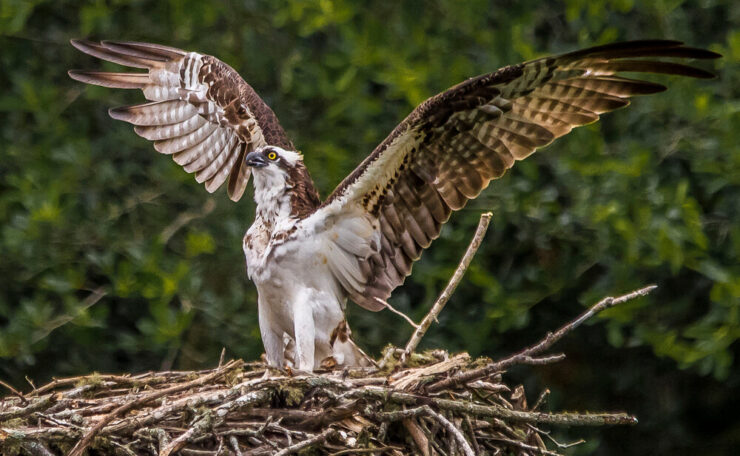Correspondence On Lighting Impacts To Wildlife Missing From Ninigret Park Plan
As part of the process to create a new Ninigret Park Master Plan, the Parks and Recreation Master Plan Update Sub-Committee established a November 10, 2023, deadline for the public to submit written comments to be considered when creating the plan and promised to include all comments as an appendix to the plan.
The final plan drafted by VHB was published on March 4 and does include an appendix with comments, but missing from the comment collection is an important letter from the Audubon Society of Rhode Island in opposition to the installation of any novel lighting near the Ninigret National Wildlife Refuge. Also missing is a 2012 letter from the US Fish and Wildlife Service in opposition to lighting in Ninigret Park that I sent as an attachment with my own correspondence. There is confirmation that the letters were received by the Parks and Recreation Department and by VHB. Why they were omitted from the collection of correspondence is unknown, but their inclusion would have provided important information about the impact that lighting has on wildlife and guided future readers in interpreting the plan.
In spite of the comments in these two letters, the final 129-page Ninigret Park Master Plan drafted by VHB includes only the following statement on lighting impacts on natural resources: “The Refuge and the Park’s coast are home to migratory birds and endangered species. Ineffective artificial lighting will impact migratory habits, reduce the area’s ecological importance, and impact the effectiveness of the Frosty Drew Observatory.”
There is no further discussion anywhere in the plan that would explain what is meant by “ineffective artificial lighting,” or what “effective” lighting might be.
The missing letters both clearly state that there is no lighting, effective or ineffective, that will not impact nesting and migratory birds in the Ninigret National Wildlife Refuge.
The November 7 Audubon letter states, “As an organization dedicated to the conservation of birds and the habitats they rely on, the Audubon Society of Rhode Island strongly opposes the installation of any novel lighting at Ninigret National Wildlife Refuge, even those deemed to be “dark sky friendly”.
The 2012 letter from the US Fish and Wildlife Service was specifically written in opposition to a proposal for dark sky–compliant sports lighting in Ninigret Park because any lighting, even the most shielded lighting, would have a negative impact on migratory birds and bats and would result in “jeopardizing attainment of the purposes for which the refuge was established under federal law.”
Why is it Important to Protect the Mission of the Ninigret National Wildlife Refuge?
The Ninigret National Wildlife Refuge was established in 1979 precisely to protect migratory birds and other wildlife. Its mission is even more important than it was in 1979. The location of the Refuge along a major migration route (the Atlantic Flyway), its extensive coastline, and its maritime shrubland habitat is very important to migratory songbirds, migratory waterfowl, and other wildlife.
The number of birds migrating through and nesting in Charlestown is significant. The bird banding station at the Ninigret National Wildlife Refuge has the highest counts of any banding station in New England, with a very high proportion of young birds making their first migration. Not only are the total numbers significant, but over 30 of the species banded on the refuge are species of high conservation concern in the United States.
Many migrant species, including those that normally eat insects, alter their diet during the fall migration to take advantage of the berries and other fruit produced in this habitat. These shrublands are scarce in Rhode Island, but the Refuge’s large area of maritime shrubland is hundreds of acres in size and is one of the largest stands of this habitat on the coast.
Migratory birds that avoid the refuge because of incompatible activities occurring in Ninigret Park are at a high risk of negative effects and are much less likely to survive.
The Ninigret National Wildlife Refuge is permanently protected, and Charlestown’s parklands are intended to buffer the Refuge from uses that are inconsistent with the Refuge’s mission. More intense development at Charlestown’s Ninigret Park will reduce the value of the Refuge to those species it was created to protect.
Click here to read the missing letter from the Audubon Society of Rhode Island Click here to read the missing letter from the US Fish and Wildlife Service Click here to read the latest version of the Ninigret Park Master PlanThere will be a Special Town Council Meeting to discuss this Ninigret Park Master Plan on April 15 at 6 p.m. at the Charlestown Elementary School, 363 Carolina Back Road.

You can learn more about the author, Ruth Platner, on her profile page.
Banner image is a photograph of an Osprey on its nest near Ninigret Park by John Zoldak.

April 8, 2024 @ 10:13 pm
Why Why Why are the powers in charge ignoring “The November 7 Audubon letter states, “As an organization dedicated to the conservation of birds and the habitats they rely on, the Audubon Society of Rhode Island strongly opposes the installation of any novel lighting at Ninigret National Wildlife Refuge, even those deemed to be “dark sky friendly”.
The 2012 letter from the US Fish and Wildlife Service was specifically written in opposition to a proposal for dark sky–compliant sports lighting in Ninigret Park because any lighting, even the most shielded lighting, would have a negative impact on migratory birds and bats and would result in “jeopardizing attainment of the purposes for which the refuge was established under federal law.” Because of SPORTS? WHAT!?
March 18, 2024 @ 6:19 pm
will the new master plan be put put up to vote so all the town citizens can have a say on this important item
March 18, 2024 @ 10:45 am
I love open and transparent government.
March 18, 2024 @ 8:30 am
Well said Ruth, and thank-you as always for providing complete information.